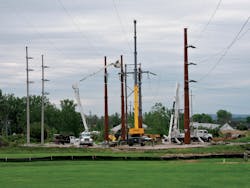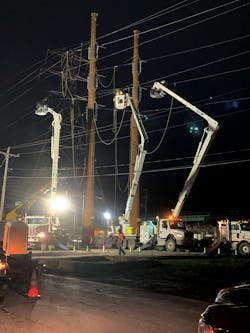Linemen Rebuild Line to Ramp Up Reliability
Linemen are swapping out older wood structures and conductors with modern equipment on a transmission rebuild project in New York State. The new lines traverse 25 circuit miles including wetlands regulated by the New York State Department of Conservation and the federal government, as well as three interstate highways, one state highway and one railroad.
National Grid owns and operates electric transmission lines within existing rights of way (ROW) in Central New York. As the contractor for National Grid, Three Phase Line Construction Inc. is rebuilding the existing Clay-DeWitt Line 3 and Clay-Teall Line 10 115 kV transmission lines, which cross through the Towns of Clay, Cicero, DeWitt, and Salina in Onondaga County, New York.
As part of its scope of work, Rochester, New Hampshire-based Three Phase Line Construction is replacing existing conductors on these two lines with new higher capacity conductors, modifying or replacing a majority of the pole structures associated with the lines, relocating a portion of the lines to the center of the ROW and other portions to a different ROW corridor. Workers are also wrecking out about four miles of existing double-circuit line.
The project, which is the largest of its kind that Three Phase Line Construction has taken on as a company, began in August 2019 and is scheduled to wrap up in 2021. Upon completion, the transmission lines will be less susceptible to outages caused by infrastructure failure, and National Grid will offer improved power reliability for businesses and the local economy. According to National Grid, the transmission rebuild project will lessen the dependence on localized electrical generating facilities and promote greater electrical generation diversity like renewables.
Overcoming Environmental Challenges
For Three Phase Line Construction, the transmission rebuild project is different from other jobs due to its size and environmental challenges. Because the job has been designated as an Article VII project, the New York State Public Service Law sets forth a process to review the need for, and environmental impact of, the siting, design, construction and operation of certain major electric and gas transmission facilities.
Because portions of this line fall within wetlands and sensitive environmental areas, the crews have to strictly follow the Environmental Management and Construction Plan (EM&CP), which was prepared by National Grid and approved by the DPS during the Article VII review process. Three Phase Line Construction always focuses on strictly adhering to environmental regulations and processes during construction. For example, National Grid’s surveyors meticulously map project limits of disturbance and delineate them in the field. All construction-related activity must remain within those limits with no exceptions. Even a single tire track left outside the limits of disturbance could result in a notice of non-compliance with the permit.
Since the company is performing a lot of its work in wetlands, its crews have had to put in place roughly 30,000 timber mats, which create temporary work platforms, roadways and staging areas. By comparison, the last environmentally sensitive (Article VII) project Three Phase Line Construction worked on required the use of 18,000 timber mats.
The number of mats is a function of how much of the project is in wetlands or agricultural land. In some instances, adhering to environmental controls means larger segments of protected area have to be matted. The work involves building a timber mat road and then building a timber mat pad around a structure to drill a foundation, install the structure and then clip in the new conductor. The drillers tend to go faster than the line crews, so Three Phase Line Construction must leave enough mats behind to allow for the line work.
When working with mats, a contractor must be flexible and adapt to changes once the work gets started. The plan might call for building a timber mat road with a 90-degree turn. In the field, however, crews may discover that if they do that, they couldn’t get a 100-ft bucket truck through the turn without encroaching on the wetland. If this happens with the Clay-DeWitt Line 3 or Clay-Teall Line projects, then Three Phase Line Construction would suggest changes to National Grid, which would amend the plan and submit it to New York State for approval.
By accounting for turnaround time for approvals like the kind mentioned above, Three Phase Line Construction keeps its crews from getting off schedule. Because Three Phase Line Construction has experience with Article VII projects, it knows how to keep work moving in other areas and stay on track and budget, while accounting for changes. Right now, Three Phase Line Construction is working through a change involving converting temporary gravel roads into permanent, permeable paver roads.
Getting the Job Done on Schedule
About 70 workers from Three Phase Line Construction and its subcontractors worked on the project at the peak of construction, and since that time, about 60 workers are still on site to finish the project. The crews are rebuilding the line with modern COR-TEN steel structures and 1113 aluminum conductor steel reinforced (ACSR) cable and tying the lines into existing substations. These lines will replace 4/O copper conductor on wood pole H-frames and steel flex towers.
The linemen are installing 184 new structures like steel monopoles, H-frames and three-pole deadends and new wooden poles. Most of these structures will be supported by the 150 new drilled pier concrete foundations with the rest being direct- embed structures. The average depth and diameter of the foundations is 30 ft deep and 8 ft wide. The project also calls for 31,000 ft of permanent gravel access road.
To keep the large transmission project on track, it takes careful and thorough planning including the coordinated scheduling of outages. With two circuits feeding four different substations, this has to happen flawlessly to keep work progressing on various parts of the line with no delays.
To progress toward the finish line, Three Phase Line Construction is focusing on good field leadership, building dedicated and experienced crews and providing them with the tools and equipment they need to do their work safely and efficiently.
As of late summer, the team is ahead of schedule on the project because its superintendent and general foreman are looking two or three weeks ahead for anything that might cause a delay. Through advance planning, they might notice that an access road has a turn that’s too sharp for a bucket truck to maneuver or that matted work pad is not big enough to accommodate the equipment needed to do the work. Through a focus on organization and preparation, Three Phase Line Construction is helping National Grid modernize its transmission system and boost power reliability in the region.
Peter Rivizzigno ([email protected]) is a senior project manager for minority-controlled business Three Phase Line Construction Inc. where he is responsible for managing the company’s transmission projects across the Northeast. He received his bachelor’s degree in geology from Miami University and master’s in geology from Duke University.
About the Author
Peter Rivizzigno
Peter Rivizzigno ([email protected]) is a senior project manager for minority-controlled business Three Phase Line Construction Inc. where he is responsible for managing the company’s transmission projects across the Northeast. He received his bachelor’s degree in geology from Miami University and master’s in geology from Duke University.


